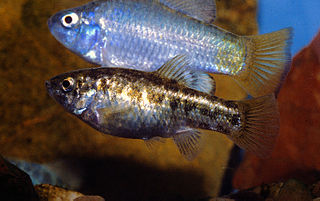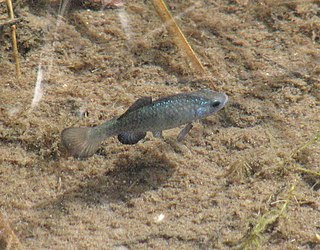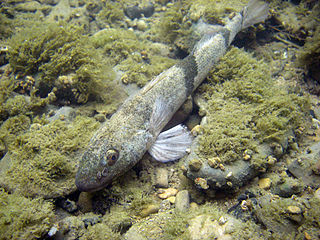
Rhinichthys, known as the riffle daces, is a genus of freshwater fish in the carp family (Cyprinidae) of the order Cypriniformes. The type species is Rhinichthys atratulus, the blacknose dace. Rhinichthys species range throughout North America.

The longnose dace is a freshwater minnow native to North America. Rhinicthys means snout fish and cataractae means of the cataract. Longnose dace are small, typically less than 100 mm and characterized by their fleshy snout that protrudes past the mouth. They are well adapted for living on the bottom of fast-flowing streams among stones. Longnose dace eat algae and aquatic insects and are important forage minnows for larger predatory fish.
The Colorado pikeminnow is the largest cyprinid fish of North America and one of the largest in the world, with reports of individuals up to 6 ft (1.8 m) long and weighing over 100 pounds (45 kg). Native to the Colorado River Basin of the southwestern United States and adjacent Mexico, it was formerly an important food fish for both Native Americans and European settlers. Once abundant and widespread in the basin, its numbers have declined to the point where it has been extirpated from the Mexican part of its range and was listed as endangered in the US part in 1967, a fate shared by the three other large Colorado Basin endemic fish species: bonytail chub, humpback chub, and razorback sucker. The Colorado pikeminnow is currently listed as vulnerable by the IUCN, while its NatureServe conservation status is "critically imperiled".

The sheepshead minnow, also known as sheepshead pupfish, is a species of ray-finned fish in the family Cyprinodontidae, the pupfishes. It is found in salt marsh and estuary environments and is native to the eastern coasts of North and Central America.

The bonytail chub or bonytail is a cyprinid freshwater fish native to the Colorado River basin of Arizona, California, Colorado, Nevada, New Mexico, Utah and Wyoming in the southwestern United States; it has been extirpated from the part of the basin in Mexico. It was once abundant and widespread in the basin, its numbers and range have declined to the point where it has been listed as endangered since 1980 (ESA) and 1986 (IUCN), a fate shared by the other large Colorado basin endemic fish species like the Colorado pikeminnow, humpback chub, and razorback sucker. It is now the rarest of the endemic big-river fishes of the Colorado River. There are 20 species in the genus Gila, seven of which are found in Arizona.

The beautiful shiner is a species of ray-finned fish in the family Cyprinidae. It is found in Mexico and Arizona and New Mexico in the United States. It is one of 22 species of Cyprinella found in North America.

The Gila chub is a species of ray-finned fish in the family Cyprinidae. It is found in Mexico and the United States. The Gila chub is closely related to the roundtail chub. This species is commonly found in association with the Gila topminnow, the desert and Sonora sucker, and the longfin and speckled dace.

The stone loach is a European species of fresh water ray-finned fish in the family Nemacheilidae. It is one of nineteen species in the genus Barbatula. Stone loaches live amongst the gravel and stones of fast flowing water where they can search for food. The most distinctive feature of this small fish is the presence of barbels around the bottom jaw, which they use to detect their invertebrate prey. The body is a mixture of brown, green and yellow.

The desert pupfish is a rare species of bony fish in the family Cyprinodontidae. It is a small fish, typically less than 7.62 cm (3 in) in length. Males are generally larger than females, and have bright-blue coloration, while females and juveniles are silvery or tan. A notable attribute of the desert pupfish is their ability to survive in environments of extreme salinity, pH, and temperature, and low oxygen content. The desert pupfish mates in a characteristic fashion, wherein compatible males and females will come in contact and collectively jerk in an s-shape. Each jerk typically produces a single egg that is fertilized by the male and deposited in his territory. Breeding behavior includes aggressive arena-breeding and more docile consort-pair breeding.

The headwater chub is a species of fish in the family Cyprinidae. It is found in Arizona and New Mexico.

The Sonoyta pupfish or Quitobaquito pupfish is an endangered species of pupfish from Sonora in Mexico and Arizona in the United States.
The carmine shiner is a freshwater fish species. In Manitoba, it was once known as the rosyface shiner. Based mostly on zoogeographic data, it is currently classified as a distinct species within the rosyface shiner species complex. The carmine shiner is a member of the Minnow family, Cyprinidae. It has the following characteristics and distinguishing features:

Eastern blacknose dace is a species of ray-finned fish in the genus Rhinichthys. Its name originates from the Old French word "dars" which is the nominative form of the word "dart" in reference to their swimming pattern. The western blacknose dace formerly was considered conspecific. While morphologically the two species are not significantly different, they are allopatric. The eastern blacknose dace is found across the southeast portion of Canada and down along the United States' east coast. It is dark brown to olive on its dorsal surface and silvery white below, the two shades separated by the darkly pigmented lateral line. In the breeding season, males develop darker pigmentation and an orange lateral line. Blacknose dace live in rocky streams and rivers where they feed upon small invertebrates and microscopic biological matter and provide forage for larger fish.
Noturus flavus, the stonecat, is a North American freshwater catfish of the family Ictaluridae. The common name is due to its habit of hiding near or under stones in fast-moving water.

Zingel asper, also known as the Rhone streber, is a species of freshwater ray-finned fish in the family Percidae that is at a high risk of becoming extinct due to habitat destruction and pollution. It is endemic to the rivers Durance and Beaume in the Rhône basin in France and Switzerland.

The pugnose minnow is a species of cyprinid fish found in the eastern North America. There are two recognized subspecies with the subspecies from Florida recognized as race peninsularis.
Nothonotus microlepidum, the smallscale darter, is a species of freshwater ray-finned fish, a darter from the subfamily Etheostomatinae, part of the family Percidae, which also contains the perches, ruffes and pikeperches. It is endemic to the southeastern United States. It occurs in the lower Cumberland River drainage in the states of Kentucky and Tennessee. It inhabits shallow riffles with gravel substrates in small rivers. Breeding habits of the smallscale darter are typical of the E. maculatum group in that females deposit large masses of eggs on the undersides of rocks to be protected by the males. This species is a fairly large, deep-bodied fish with dark background coloration mixed with bright red spots scattered alongside the body. Nuptial males of this species also have deep green fins with orange margins on the spinous dorsal and caudal fins, with the soft dorsal fins having a dark coloration moving marginally to yellow-orangish center with black margins. This species can reach a length of 7.2 centimetres (2.8 in) TL though most only reach about 4.8 centimetres (1.9 in).

The Savannah darter is a species of freshwater ray-finned fish, a darter from the subfamily Etheostomatinae, part of the family Percidae, which also contains the perches, ruffes and pikeperches. It is endemic to the eastern United States, where it occurs in the Edisto, Combahee, Broad and Savannah River drainages in South Carolina and Georgia. It inhabits gravel riffles, gravel and sand runs of creeks and small rivers. This species can reach a length of 7.4 cm (2.9 in).

The slim minnow is a species of freshwater ray-finned fish from the family Cyprinidae, the carps and minnows which is endemic to the United States, in Ozarks of Arkansas, Kansas, Missouri, and Oklahoma.

The Rio Grande sucker is a North American freshwater fish in the family Catostomidae. It has a typical bottom-feeding phenotype and fills lower trophic levels alongside Rio Grande cutthroat trout and Rio Grande chub species. It is smaller sized in comparison to its other family members, with females being the larger between sexes. Coloration tends to benefit the species due to counter-shading patterns. It is endemic to the Rio Grande basin and was once common throughout. The species has maintained a population in New Mexico, Colorado, Arizona, and Northern Mexico, but has faced challenges from the pressure of non-native species, habitat loss, degradation, and a variety of other aquatic ecosystem changes. There is current pressure from environmental organizations to federally list the species as threatened or endangered.


















